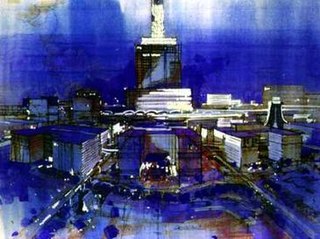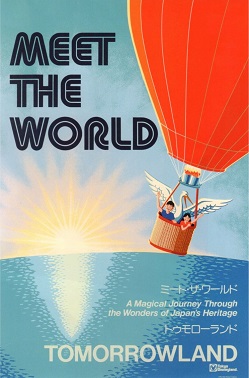
Epcot, stylized in all uppercase as EPCOT, is a theme park at the Walt Disney World Resort in Bay Lake, Florida. It is owned and operated by The Walt Disney Company through its Experiences division. Inspired by an unrealized concept of the same name developed by Walt Disney, the park opened on October 1, 1982, as EPCOT Center, and was the second of four theme parks built at Walt Disney World. The park spans 305 acres, more than twice the size of Magic Kingdom. Often referred to as a "permanent world's fair", Epcot is dedicated to the celebration of human achievement, particularly technological innovation and international culture.

The Experimental Prototype Community of Tomorrow, shortened to EPCOT or E.P.C.O.T., was an unfinished concept for a planned community, intended to sit on a swath of undeveloped land near Orlando, Florida. It was created by Walt Disney in collaboration with the designers at Walt Disney Imagineering in the 1960s. Based on ideas stemming from modernism and futurism, and inspired by architectural literature about city planning, Disney intended EPCOT to be a utopian autocratic company town. One of the primary stated aims of EPCOT was to replace urban sprawl as the organizing force of community planning in the United States in the 1960s. Disney intended EPCOT to be a real city, and it was planned to feature commercial, residential, industrial, and recreational centers, connected by a mass multimodal transportation system, that would, he said, "Never cease to be a living blueprint of the future".

Walt Disney's Carousel of Progress is a rotating theater audio-animatronic stage show attraction in Tomorrowland at the Magic Kingdom theme park at the Walt Disney World Resort in Bay Lake, Florida just outside of Orlando, Florida. Created by Walt Disney and WED Enterprises as the prime feature of the General Electric (GE) Pavilion for the 1964 New York World's Fair, the attraction was moved to Tomorrowland at Disneyland in Anaheim, California as Carousel of Progress, and remained there from 1967 until 1973. It was replaced in Disneyland by America Sings in 1974, and reopened in its present home in the Magic Kingdom in 1975.

The PeopleMover is an attraction in Tomorrowland in the Magic Kingdom at the Walt Disney World Resort in Bay Lake, Florida just outside of Orlando, Florida. Designed as an urban mass-transit system of the future, vehicles take passengers on a grand circle tour of the realm of Tomorrowland that provides elevated views of several other attractions.

Tomorrowland is one of the many "themed lands" featured at all of the Magic Kingdom styled Disney theme parks around the world owned or licensed by The Walt Disney Company. Each version of the land is different and features numerous attractions that depict views of the future. Disneyland Park in Paris includes a similar area called Discoveryland, which shares some elements with other Tomorrowlands but emphasizes visions of the future inspired by Jules Verne.

Spaceship Earth is a dark ride attraction at the Epcot theme park at the Walt Disney World in Bay Lake, Florida. The geodesic sphere in which the attraction is housed has served as the symbolic structure of Epcot since the park opened in 1982.

Journey into Imagination with Figment is the third and latest incarnation of a dark ride attraction located within the Imagination! pavilion at World Celebration at Epcot, a theme park at the Walt Disney World Resort in Bay Lake, Florida. Originally opened on March 3, 1983, its original and current version feature the small purple dragon named Figment as well as the song "One Little Spark", composed by the Sherman Brothers.
The Omnimover is an amusement ride system used for Disney theme park attractions. Roger Broggie and Bert Brundage developed the system for WED Enterprises, which patented Omnimover in April 1968. The term was coined by Imagineer Bob Gurr. Outside of Disney, it is sometimes known as an Endless Transit System.

Test Track is a high-speed slot car thrill ride manufactured by Dynamic Attractions located in World Discovery at Epcot, a theme park at the Walt Disney World Resort in Bay Lake, Florida. The ride is a simulated excursion through the rigorous testing procedures that General Motors uses to evaluate its concept cars, culminating in a high-speed drive around the exterior of the attraction.

World of Motion, presented by General Motors, was the former occupant of the transportation pavilion in Epcot at Walt Disney World Resort. It was an opening day attraction at EPCOT Center in 1982 and it closed in 1996 to make way for Test Track, a new thrill ride through a GM testing facility.

The Wonders of Life pavilion was an attraction at Epcot at Walt Disney World in Lake Buena Vista, Florida. It was devoted to health care, focusing on the human body, physical fitness, medicine and nutrition. Attractions included Body Wars and Cranium Command. It is located inside a golden colored dome between Mission: SPACE and Wonders of Xandar. It opened on October 19, 1989, and closed on January 1, 2007. From 2007 to 2018, the Pavilion acted as EPCOT's Festival Center, before becoming a construction site in March 2019 in preparation for the upcoming Play! Pavilion to replace it.

The Land is a pavilion located in the World Nature neighborhood of Epcot, a theme park at the Walt Disney World Resort in Bay Lake, Florida. The pavilion is dedicated to human interaction with the Earth, focusing on agriculture, conservation, and travel. It opened on October 1, 1982, as part of the Phase I features for the grand opening of what was then known as EPCOT Center. It explores how humans can both use the land for their benefit, and how they can also destroy it. Future Technology in better preserving the land is also explored in the pavilion, along with a focus on the celebration of the land itself.

Meet the World was an attraction at Tomorrowland in Tokyo Disneyland that operated from 1983 until 2002. It was a show that explored the history of Japan over the course of 19 minutes, focusing specifically on the history of Japan's engagement with the outside world. The show featured an animated crane explaining Japanese history to a young boy and girl from Yokohama. The show featured dialogue between a number of audio-animatronic figures and a movie screen in the background. Park guides and maps said "explore Japan's heritage in an incredible time-travel adventure!"

WestCOT was a planned second theme park for the Disneyland Resort in Anaheim, California. It was essentially a replica of EPCOT Center at the Walt Disney World Resort in Lake Buena Vista, Florida, and was dedicated to the celebration of human achievement, namely technological innovation and international culture. The park was represented by SpaceStation Earth, a larger version of the geodesic sphere Spaceship Earth featured at EPCOT Center.

Mission: Space is a space exploration-themed pavilion and attached centrifugal motion simulator attraction located in the World Discovery section of Epcot at Walt Disney World in Bay Lake, Florida. The attraction simulates what an astronaut might experience aboard a spacecraft on a mission to Mars, from the higher g-force of liftoff, to the speculative hypersleep. The pavilion also includes the Mission Space: Cargo Bay gift shop, the Advanced Training Lab interactive play area and Space 220 Restaurant.
"There's a Great Big Beautiful Tomorrow" is the theme song to two Disney attractions, Walt Disney's Carousel of Progress at the Magic Kingdom of Walt Disney World and Innoventions at Disneyland. It was also used in one scene of the Epcot attraction Horizons.

Body Wars was a motion simulator attraction inside the Wonders of Life pavilion at the Walt Disney World Resort's Epcot. Riders would be taken on a mission by the fictional Miniaturized Exploration Technologies corporation to study the effects of the white blood cells on a splinter inside the left index finger of a volunteer. The attraction used the Advanced Technology Leisure Application Simulator technology previously seen at Disneyland's Star Tours attraction. The ride is no longer in operation along with the other attractions inside the Wonders of Life pavilion, which opened on October 19, 1989, and closed on January 1, 2007.

Space Mountain is an outer space-themed, indoor roller coaster in Tomorrowland located at Walt Disney World's Magic Kingdom theme park in Bay Lake, Florida, near Orlando. The dark ride, which opened on January 15, 1975, is the original version of the iconic attraction that has since been replicated at other Disney theme park locations worldwide, with the exception of Shanghai Disneyland Resort. Space Mountain is one of the first computer operated roller coasters and is also the oldest operating roller coaster in the state of Florida.
George Wilkins is an American soundtrack composer who has created several noteworthy scores and songs for Walt Disney Parks and Resorts.






















